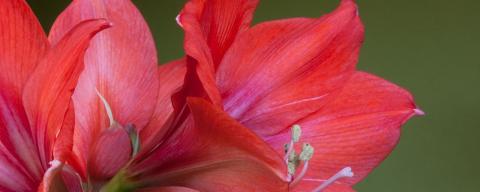Can I Get My Amaryllis to Bloom Again?
Although amaryllis are typically only sold around the holidays, they can be grown successfully year-round and bloom again as long as they receive proper care.
After The Initial Bloom
They key to re-flowering is simply making sure the plant stays healthy and growing. If your amaryllis has finished flowering, cut off the spent blooms to prevent the plant from going to seed. Make a point of only removing the spent flowers and leaving the flower stalk until it turns yellow or begins to wither. The flower stalk is capable of photosynthesis and will help create new energy that will recharge the bulb.
Caring For Your Amaryllis
Next, place the amaryllis in the sunniest spot possible in your home. A window with a southern exposure is the best choice. The long, strap-like leaves of amaryllis will photosynthesize and create energy that is stored in the bulb and used to create future flowers. An actively growing plant will require frequent watering and fertilization. Water when the soil at the top of the pot is dry, and apply a balanced liquid fertilizer every 2-4 weeks. Once the risk of frost has passed in the spring, move your amaryllis outside for the summer where it can receive more sunlight. Like any other houseplant, the amaryllis should be gradually hardened before placing it in direct sun to avoid burning foliage. Start by placing the bulb in a shady place and gradually expose it to more sun each day over a week-long period. Once the amaryllis has adjusted to outdoor conditions, bring it into an area with full sun and continue to water and fertilize regularly. Bring the plant back indoors before the first frost.
Repotting Considerations
There is likely no need to repot your amaryllis in the first season. Amaryllis actually grow best when they are slightly pot-bound and may only need to be repotted every three or four years.
Forcing Dormancy
Unlike other bulbs, Amaryllis does not require a dormant period in order to flower. However, if you want to time your plant’s bloom around the holidays the bulb must be forced into dormancy in the fall. When you bring your amaryllis indoors, store it in a cool, dry, and dark place. Let the leaves die back before cutting them off and do not water. After 10-12 weeks, move the bulb back into a bright, sunny place and begin watering and fertilizing once more. If your amaryllis has been well-cared for, you can expect to see flower development in 4-6 weeks.
Related Resource(s)
Do you love learning about stuff like this?
SUBSCRIBE TO Granite State Gardening newsletter
Got questions? The UNH Extension Yard and Garden Infoline offers practical help finding answers for your yard and garden questions.
Call toll free at 1-877-398-4769, Monday to Friday, 9 a.m. to 2 p.m., or fill out webform.

